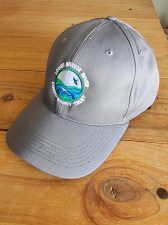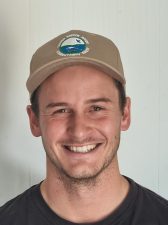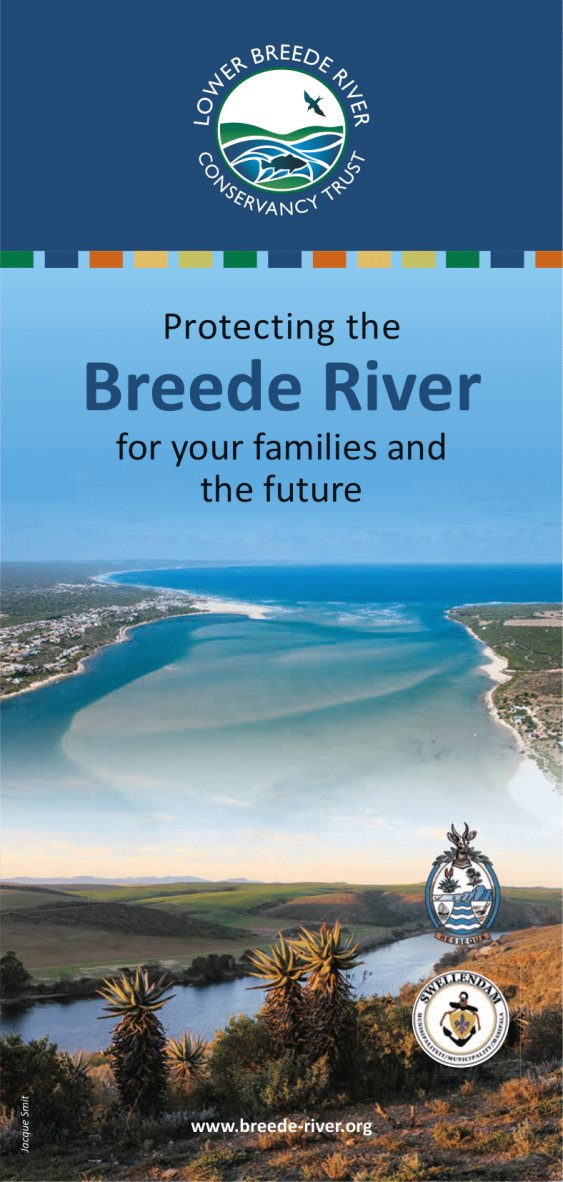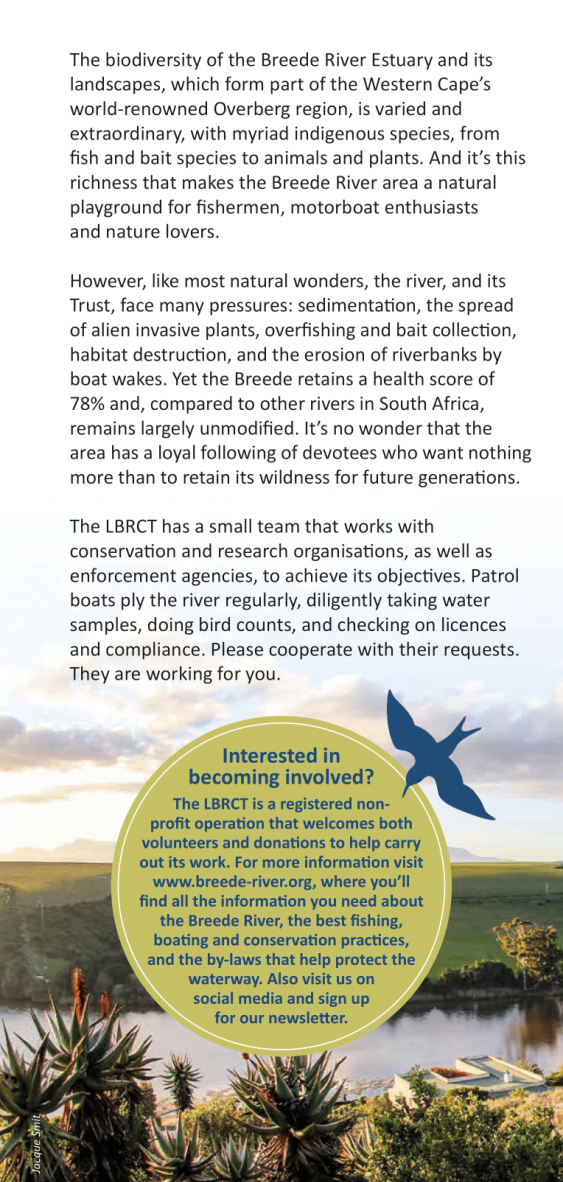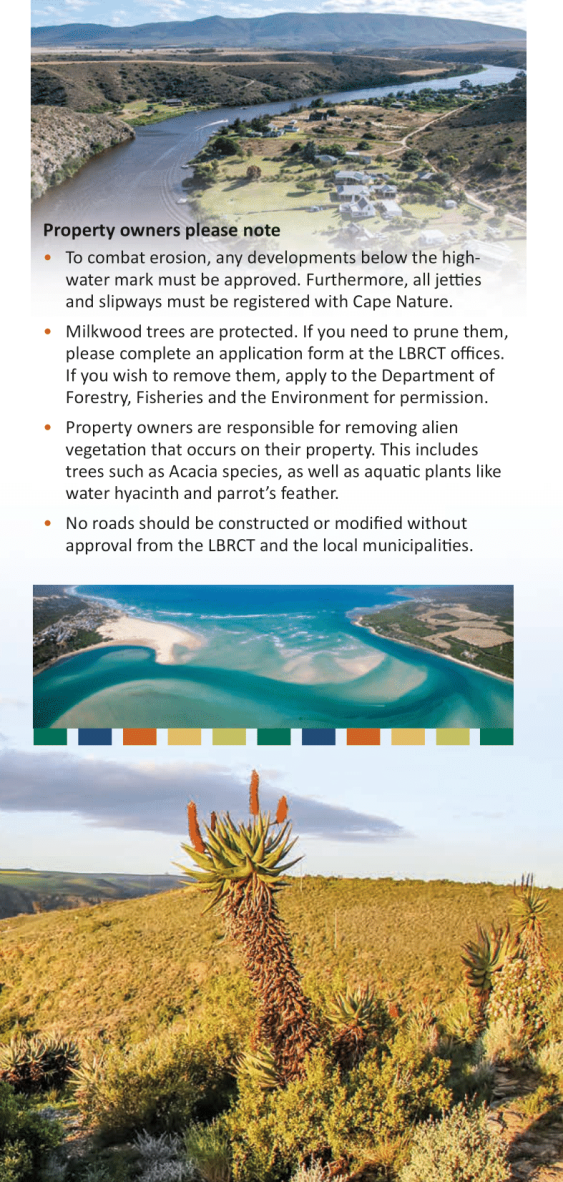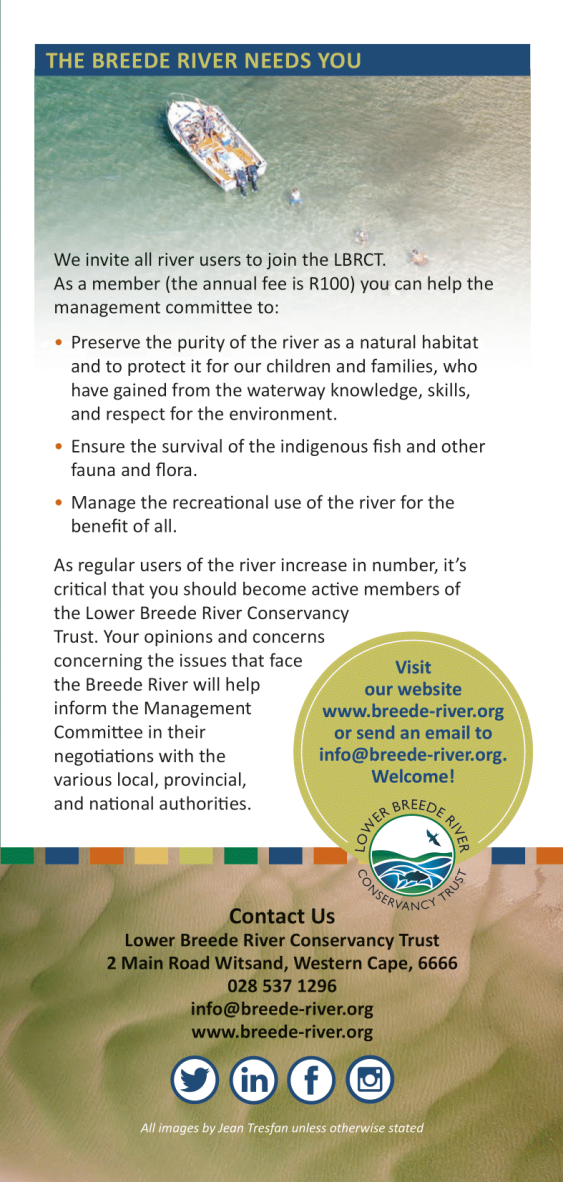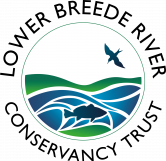

Issue 37
December 2021
Grunter Bay Shows Signs of Recovery

Grunter Bay is a salt marsh habitat located approximately four kilometres from the mouth on the west bank of the estuary. Salt marshes are important habitats as they provide essential ecosystem services that maintain the health of the estuary. The type of vegetation present in these environments control erosion, filter excess nutrients and pollutants, reduce stormwater runoff and also the chance of flooding. They create habitats for a wide range of terrestrial and aquatic animals.
Salt marshes are sensitive environments. An increase in recreational boating and fishing activity, combined with natural phenomena such as climate change, and drought, has had a significant impact on the main salt marsh, Groenpunt, and its smaller counterpart - Grunter Bay. Of particular concern is erosion of the banks, caused in part by wind and wave action, but aggravated by human disturbance. Shallow mudflats typical of this habitat at high tide make them popular fishing locations where anglers and passers-by at times tend to trample the vegetation and bank edges to reach desirable spots. Grunter Bay has been experiencing dramatic degradation over the last few years, with man-made footpaths continually widening, and the edge of the marsh bank receding by as much as five metres in the last five years.
In November, we erected seven signs at the marsh to educate members of the public about the importance of salt marshes in hopes of protecting and restoring Grunter Bay. The signage states that erosion and vegetation damage is occurring and requests that people keep to the footpaths and off the bank edges. This task was not easy; ground rock was reached at a shallow depth and we needed to make use of a jack hammer and concrete to permanently secure the poles. It is our aim to see this area slowly recover. Your cooperation and support is greatly appreciated.
Many thanks to Shaun Sale from Sale's Hire for supplying the Conservancy with a powerful jack hammer and generator. These tools were perfect for the job.
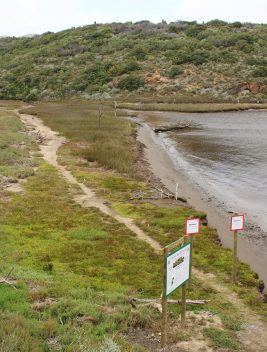
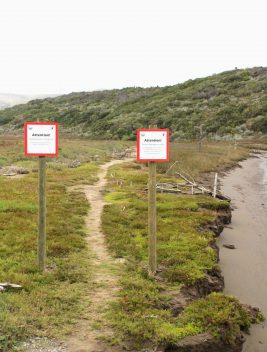
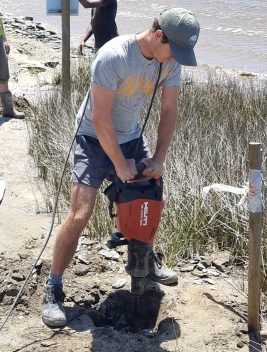
A Big Thank You To Falcon Inflatables!

Falcon Inflatables has been a trustworthy boat manufacturer, owned by the Heyneman family, who have been producing quality RIBS since 1985. In November, the LBRCT received a very generous offer from the Heynemans - the use of the old Witsand NSRI Station 33 vessel for river patrols. This 4.5 metre RIB was returned by the NSRI and has been fitted with a centre console and 50 horsepower engine. The arrangement materialised because all parties believe that the boat belongs on the Breede River. It has previously rescued many people and tackled massive swells out at sea, making it most competent for river patrolling and conservation projects.
Many thanks from the Lower Breede River Conservancy Trust to Chris Heyneman and the Falcon Inflatable team for this valuable contribution.
Good news for the Dickson's Copper butterfly
The Dickson’s Copper butterfly (Chrysoritis dicksoni) was originally discovered by Charles Dickson near Melkbosstrand on South Africa's west coast. This critically endangered butterfly has a history of disappearing from its known habitats and being rediscovered. Today the only known population of this species occurs just outside of Witsand on the south coast, more than 200 km away.
Spread out over 80 ha, there are a few sub-populations of the Dickson’s Copper at the Vondeling and Westfield farms outside Witsand, especially where Canca Limestone Fynbos occurs. The sandy habitat is characterised by restios (a type of fynbos grass) and low shrubs with rocky limestone outcrops.
Interestingly, Black Cocktail ants (Crematogaster peringueyi) are responsible for feeding the butterfly larvae via mouth-to-mouth transfer of nutritional fluids. This feeding mechanism is called trophallaxis. In this area, the ants tend to nest in Blue Kunibush (Searsia glauca). Adult female butterflies specifically choose to lay their eggs, or oviposit, on these bushes where the ants are present. They do so by picking up on chemical cues secreted by the ants.

The Dickson's Copper butterfly (Chrysoritis dicksoni) is endemic to Witsand and is critically endangered.
Indeed, the Dickson’s Copper is very dependent on the presence of Black Cocktail ants for successful reproduction. But what’s in it for the ants? Well, nothing actually. Chrysoritis dicksoni is a social parasite; it is hypothesised that the butterfly larvae trick the ants into feeding them by producing pheromones and acoustic sounds that mimic those of the queen ant. The ants are none the wiser and give the butterfly larvae feeding priority over their own larvae.
A recent 2021 survey revealed that Black Cocktail ants have recovered from a recent controlled burn in the Westfield population. Wandering Dickson’s Copper butterflies will soon recolonise these areas. Let’s hope that the last remaining known population of this species will grow in numbers in the years to come!
Monthly Monitoring
Water Quality and Bird Count
The LBRCT conducts a monthly bird count and water quality run on the Breede River. Both operations are conducted at spring low tide (full moon and new moon). For the water quality run this is to account for the pushing tide increasing the salinity of the water upriver as we travel, and for the the bird count it is to observe the birds as they forage on the exposed mudflats.
For the latest results please click here.
Its Fire Season!
Here's what you need to remember when burning:

- Permits are issued for different lengths of time depending on the time of year and the type of burn (stubble lands, ecological, rubbish heap, etc.). Please inquire at your local fire station for more information.
- The Fire Brigade does an inspection before issuing the permit. The Overstrand Municipality currently charges a consultation fee.
- You may not burn on a Friday, Saturday, Sunday or public holiday.
- You may only burn on a Friday or the day before a public holiday with special permission from the Fire Brigade.
- You may not burn on an Orange or Red (Fire Danger Index) day.
- You are bound by the personnel and equipment numbers as declared in the application.
- You must inform your neighbours and/or other authorities 2 weeks prior to the burn and again daily before burning starts.
- You must inform the control centre or local fire station daily before burning starts.
- All fires have to be extinguished before 16:30 daily.
- Patrol the area until the burnt area is cold.
- You are responsible for the burn and its consequences.
Mission Statement
The mission of the LBRCT is to conserve and protect in a sustainable manner, the natural resources and living species in the biological and ecologically sensitive Breede River Estuary and the adjoining land areas while at the same time promoting safe and lawful recreational use.
If you take an active interest in, or use, the Breede River Estuary we hope that you will consider becoming a member of the LBRCT and support our endeavours by contributing to these efforts.
Meet our new Trustees
Andrew Crawford
Andrew Crawford is a homeowner on the Breede River who has been visiting the area for more than 20 years. He is the owner of a manufacturing business, has commerce bachelor and masters degrees from Rhodes and UCT and focuses primarily on the operational oversight of the LBRCT.
David Rogers
David studied environmental science at University of Cape Town and has spent much of his life as a writer, photographer and environmental journalist. In addition to his many popular articles for Getaway, Travel Africa, Geo, and Nat Geo Traveller, he has also written and photographed more than 18 books on Africa including Living Landscapes of Southern Africa. He firmly believes that the Breede River needs to be protected for the next generation and that we need to firm up on conservation, particularly protecting the plant species which make this are so unique. David Rogers first came to Breede 47 years ago with his parents camping on the riverbank in Area One.
Giles Buswell
Giles Buswell is a practising attorney with degrees from Rhodes and UCT in law, tax, chemistry, and microbiology. He lives and practices in Cape Town, punctuated by visits to the Breede River. His mother first bought at the River in 1985 and the family has been going down ever since, with Giles eventually taking ownership of the property. Together with his wife, they have watched their children grow up on the river and become confident young adults, making many happy memories along the way. It is a legacy they hope to pass along.
Geoff Brownell
Geoff Brownell is passionate about the Breede River Estuary. He spent his first holiday on the river in 1962 at the Mudlark Riverfront Lodge. Geoff met his wife, an Infanta girl, at a New Year's Eve Party on the river in 1968. He bought Dusky 'Perch' in Infanta in 1981, then built and “moved” to the river in 1999. He is hugely aware of the importance of conserving the area for future generations with all role layers being involved, from Infanta and Witsand to beyond Malgas. He also considers himself extremely fortunate to have his family spend most holidays in the area. Geoff loves light tackle fishing from his slipway, music and boats and has been involved in the building material supply business since 1972.
Snake Awareness and First Aid

Puff Adder © Jacque Smit
Its snake season, and at the Breede you can expect to see a number of venomous and non-venomous species. Bites are uncommon, but not unheard of, and for that reason every responsible person should have a basic understanding of which snake species occur here and what first aid to apply.
The three most common dangerous snakes are the Puff adder, Cape cobra and Boomslang. Puff adders are ambush predators which lie well camouflaged and wait for mice to pass by. They get their name from their habit of taking in lots of air when feeling threatened and exhaling it slowly to make a loud puffing noise.
The Puff adder is a slow-moving snake, but it has the fastest strike of all southern African snakes. They strike multiple times within milliseconds. Watch this incredible video which slows down a rapid strike to reveal
several bite attempts. The venom of Puff adders is predominantly cytotoxic, meaning it affects local tissue and causes damage to muscle cells. The Night adder is another snake with this venom that occurs here.
Cape cobras are more mobile than puffies and actively hunt for prey. They pack a potent neurotoxic venom which affects the peripheral nervous system. The respiratory muscles are gradually paralysed leading to respiratory failure. In October Gillie Gunter recorded this video of a standoff between a Cape cobra, mongoose and two crows - watch here.
The Boomslang is a shy tree snake which can sometimes be seen hunting birds and foraging their nests. They are fast snakes which have relatively short fangs situated at the back of their mouth. Nearly all snakes can open their mouths 180° when striking, so do not believe the misconception that a back-fanged snake cannot bite you. Boomslangs have haemotoxic venom. This venom affects the clotting mechanism of the blood. Here's a video of a Boomslang getting dive-bombed by weavers as it raids their nests at Bent Head Pub - watch here.
Common non-venomous snakes include Mole snakes, Egg-eaters and Brown house snakes. Egg-eaters and Night adders look very similar, both in patterning and size, but there are some key differences to look out for so that you do not confuse the two:
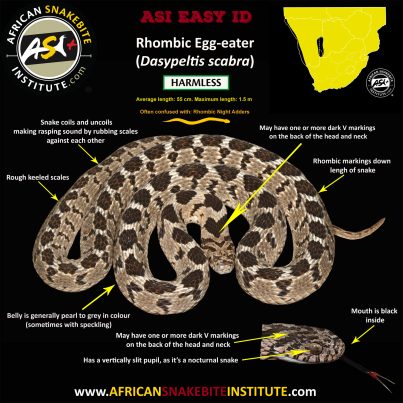
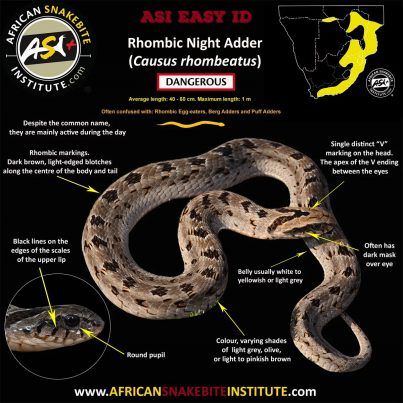
In any event of a snake bite:
DO NOT | DO |
|---|---|
Do not apply an arterial or venous tourniquet. | Get the patient to a medical facility as soon as possible in a safe manner. This is by far the most important first aid measure. Keep the number of the closest hospital with a trauma unit, as well as the nearest ambulance service on your cell phone. |
Do not cut or suck out the venom. | Download the African Snakebite Institute App. It has sections on first aid, medical treatment, snake identification, a list of hospitals countrywide, and more. |
Do not apply electric shock therapy. | Identification of the snake may be helpful to the treating doctor. If safe to do so, photograph the snake. |
Do not apply ice or heat. | Keep the patient calm and immobilised. More than 99% of snakebite victims that are hospitalised within a few hours survive their snakebites. |
Do not inject antivenom routinely as a first aid measure. Most snakebite victims do not require antivenom. If required, antivenom must be injected intravenously by a medical doctor in large quantities (6 - 10 ampules or more). As victims may go into allergy-induced shock when injected with antivenom, assisted resuscitation, adrenalin and other drugs may be required. | If you are more than an hour away from the nearest hospital after a Cape cobra bite, consider applying a pressure bandage to the affected limb. Do not apply a pressure bandage if swelling is already present or if the victim was bitten by an adder. |
Conservancy Caps
Exclusive to Members
For just R200, you can be a proud ambassador of the Lower Breede River Conservancy Trust. Our embroidered peak caps are durable and come in a variety of colours, namely grey, khaki and charcoal. This offer is exclusive to paid up members.
If you would like to order one or more caps, please send an email to info@breede-river.org
We've updated our Information Brochure
